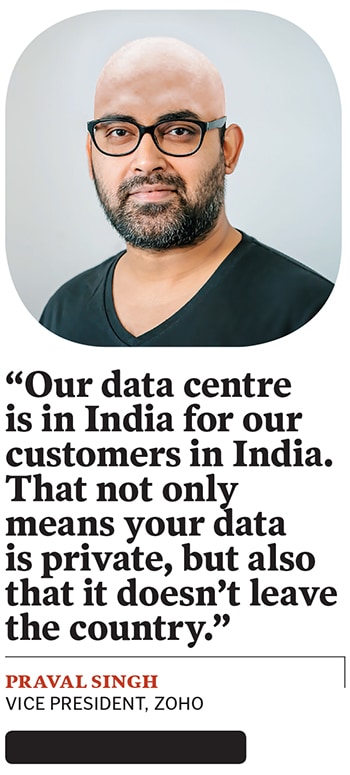Mitron, Chingari, Zoho: Can Indian apps win the user war?
Indian alternatives to Chinese apps are seeing a surge in downloads after the government banned 59 from the neighbouring country following the Galwan standoff


 Shivank Agarwal (left), and Anish Khandelwal built short video app Mitron that is being used as a replacement for TikTok[br]Sankalp R Nag felt it was his nationalistic duty to switch to Indian apps after the border face-off between India and China in Galwan Valley in June. The government’s announcement to ban 59 Chinese apps immediately after the standoff only reinforced his belief. Nag, who runs a gems and jewels shop in Zaveri Bazar, South Mumbai, uninstalled TikTok, where he would occasionally upload videos, and downloaded its Indian alternatives, Roposo and Mitron.
Shivank Agarwal (left), and Anish Khandelwal built short video app Mitron that is being used as a replacement for TikTok[br]Sankalp R Nag felt it was his nationalistic duty to switch to Indian apps after the border face-off between India and China in Galwan Valley in June. The government’s announcement to ban 59 Chinese apps immediately after the standoff only reinforced his belief. Nag, who runs a gems and jewels shop in Zaveri Bazar, South Mumbai, uninstalled TikTok, where he would occasionally upload videos, and downloaded its Indian alternatives, Roposo and Mitron.
“I found these apps way better than TikTok. After the ban, my TikToker friends and my sister—who had thousands of followers—also opted for the Indian options,” says Nag, 23, who found out about the alternatives via WhatsApp. He also replaced ShareIt with Google Drive and Dropbox to share large files. Emphasising that such steps can hurt China in myriad ways, he adds that they’ve even stopped using and selling Chinese pearls and stones at his shop, Quality Jewels.
At a time when anti-China sentiment is high, many like Nag are shifting their allegiance to Indian apps. On June 29, the ministry of information technology banned 59 Chinese apps, saying they were “prejudicial to the sovereignty and integrity of India, defence of India, security of state and public order”. Asian News International on July 8 reported that the Indian Army has asked its personnel to delete 89 apps—some Chinese ones, including TikTok, UC Browser and CamScanner, among many others, as well as Facebook, Instagram, Truecaller and ShareChat. On July 27, the government banned an additional 47 Chinese apps that were acting as clones to the previous banned apps. On the newly banner list are apps including TikTok Lite, Helo Lite and Bigo Lite among others.
It is believed that these apps provide data from Indian users to the Chinese government. The ministry said the ban was to “safeguard the interests” of the world’s second highest number of internet users and “to ensure safety and sovereignty of the Indian cyberspace”.
The ban is perceived by many as a soft attack on China, many Indians had also benefited from these Chinese apps—while several earned a chunk of their livelihoods by posting content on platforms such as TikTok, others garnered millions of followers and created a name for themselves with their videos.The users are now are finding replacements in Indian apps, which claim to also be addressing many of the data security and privacy concerns posed by their Chinese counterparts. Alternatives to TikTok—Mitron, Chingari, ShareChat’s Moj, Roposo and smaller players such as BoxEngage and Aiisma—claim to have seen a surge in downloads in the last couple of weeks. Mitron says it saw an 11-fold growth after the ban, while Chingari saw over 2.5 million downloads since then. Even bigger companies like Zee5 and Gaana have launched HiPi and HotShots respectively to tap the short video space.
“We are committed to data privacy, security and compliance with local laws, and have taken several measures to ensure they are reflected in our product. We have done security audits too and will continue to do so,” says Shivank Agarwal, founder and CEO of Mitron, a short video and social platform. “We ensure that our users’ data is stored on Indian servers and is accessible only on Mitron servers running on Indian data centres. We empower our users to have control of their data… they can choose to delete any content uploaded by them. Shortly, we will also enable them to control the visibility of their content.”
Agrees Praval Singh, vice president of Zoho. The company’s Zoho Doc Scanner—its answer to the banned Chinese app CamScanner, which scans documents with a phone camera—has seen a 20x daily increase in downloads on the Apple App Store and 30x increase on Google Play Store.
“Zoho thrives on privacy and security… 100 percent of our revenues come from subscription fees, not advertisements. Our data sits within Zoho… it doesn’t go to any third-party advertisers or partners. Also, our data centre is in India for our customers in India. That not only means that your data is private, but also that it doesn’t leave the country. Everything is controlled… from the physical layer and the app layer to cloud. That gives our apps extra security,” says Singh.
He, however, concedes that CamScanner did to the market what Maggi did to instant noodles and Jeep to SUVs. The app became the product. “It came early in the market and got it right all the way with great execution,” he says about CamScanner’s success.
Several other Chinese apps enjoyed roaring popularity in India. TikTok, for example, became a rage and was the biggest in terms of downloads and user base in the industry of short video platforms. It provided an easy outlet to anyone—from a villager to an entrepreneur—with a mobile phone to showcase their talent and creativity.
TikTok comes and starts dumping $50 million a month… how will [a venture capitalist or VC] allow it? No VC in the world wants to take the huge might of ByteDance. Our ecosystem was killed before it got built,” says Anand Lunia, founding partner at India Quotient, which backed startups such as ShareChat and Roposo at the seed stage. “Google and Facebook are monopolies and they’re abusing their monopoly status. Most startups end up spending more to acquire customers.”
Industry experts believe the acquisition of users has become easier for Indian startups following the ban. However, their ability to stay will depend on the features and user interface (UI) of the apps.“These Chinese platforms, on the back of large marketing budgets, were aggressively tapping Indian internet users. It was a tough battle for their Indian counterparts to fight them head on,” explains Pulkit Sharma, co-founder and CEO of Khabri—a digital audio platform for content in vernacular languages—which is seeing positive results after Chinese rivals like NewsDog, UC News and QQ NewsFeed got banned. “The exciting part is that more and more users are promoting our app as an Indian app, and inviting other Indians to join. Our app was trending at No 4 on Google Play Store.”
The financial implications of the ban are also evident. Whenever a non-Indian app generates revenues, the money goes to the country where the parent is based out of. Lunia says usually top talent is recruited from there and smaller roles are filled here. “From an economic standpoint, let the likes of Amazon and TikTok come to India, but they must make sure they hire local engineers, put capital here, develop the product here… then let there be a fair fight,” he says.
The fear of data being compromised resulted in the birth of India’s first indigenously developed social networking super app, Elyments. Launched on July 5, it garnered over 2 million downloads in three days and enjoyed a 4.3 star-rating with over 50,000 reviews. It contains chats, audio and video calls, sharing and liking features, following and discovering influencers, and entertainment options like games. Elyments also plans to tap into conference calls, payments, commerce and other areas in the future.
“More than 500 million Indians use social media and yet none of the major platforms is Made in India. The data collected by these apps leaves the country, and India has no control or jurisdiction over how that data gets used,” says Rajesh Krishnamurthy, creator of Elyments.
Likee, a Singapore-based (parent company Joyy is Chinese) short video creation and sharing platform, declined to take Forbes India’s questions while a questionnaire sent to Chinese web browser UCWeb remained unanswered at the time of going to press. Nikhil Gandhi, India head of TikTok, said in a statement: “We are in the process of complying with the government’s interim order. We have been invited to meet with the concerned government stakeholders for an opportunity to respond and submit clarifications. TikTok continues to comply with all data privacy and security requirements under Indian law and has not shared any information of our users in India with any foreign government, including the Chinese government. Further, if we are requested to in the future we would not do so. We place the highest importance on user privacy and integrity.”
The Next Big Thing
While the Indian apps remained in the shadow of the bigger Chinese players so far, the ban provides them an opportunity to become the ‘next big thing in India’.
“When we started, we were trying to find our place in a category that was dominated by one large player. But we believed in our mission to build an Indian app for Indian users that respects Indian community standards and laws. Even before the ban on TikTok, Mitron was rapidly gaining ground and we reached the No 1 spot on Play Store,” claims Agarwal.
There have been setbacks along the way though. For instance, when Mitron was removed from Play Store for not complying with policies. Explains Agarwal: “We were just two of us [in the team] then. Play Store has a number of policies that every app has to adhere to. One of them is to have a feature for users to flag inappropriate content in UGC apps which Mitron didn’t have at that time. We immediately addressed that issue.”
With the Chinese presence wiped out from phones, it is likely that some of these players will find their moment in the spotlight. “Within the next three months, you will see two or three leaders emerging,” says Lunia, adding that the market will go from one leader in a segment to multiple players in the same. And some of these players are working on providing additional features and an Indian touch to woo users.
BoxEngage, which claims to be a “better Indian alternative of TikTok”, saw 10x surge in monthly active users from 50,000 to 500,000 with over a million signups since the ban. The company pivoted its model from offline entertainment to online after the lockdown. “TikTok was a short video format hosting platform where you could follow and comment,” says Varun Bajaj, co-founder of BoxEngage. “BoxEngage allows Indian content creators to post multiple formats—short and long video—as well as live video for influencers to connect with their fans.”
Aiisma is neither only a content platform nor another TikTok. Instead of offering people money for taking part in surveys, it created a social platform around it. It was established with the idea of creating a market for user data where people can create 360 degree content format, including videos, pictures and opinions, with rewards or compensations aligned with each. “So far, we’ve not engaged in any marketing cycle since our launch about eight weeks ago. Yet, we have been seeing up to 100-250 percent week-on-week increase in our subscriptions,” says Ankit Chaudhari, founder and CEO, Aiisma.
“This app has given a push to anything which can replace TikTok, but we never positioned ourselves as its replacement. TikTok is a small part of our social media platform which is in conjunction with photographs, podcasts and opinions,” he adds.
Zoho Doc Scanner’s Singh, too, says they are developing the product at a rapid pace. “We have close to 21 features of which 18 are available on the free app. You don’t just want to convert photos to PDF, you want to organise documents in folders with tags, translate it into the 17 languages (premium). It’s taking it to the next level.” What Lies Ahead
What Lies Ahead
It’s one thing to be successful at a time when China is perceived to be an enemy, and another to sustain that popularity over the long term. The prime minister’s clarion call for Atmanirbhar Bharat gives Indian apps a headstart, but they need to be on their toes.
Not everyone is impressed with them yet. Vaishali Ankur Ayya, a graphic designer, who used to spend an hour a day browsing the content on TikTok, misses it even more now. She found alternatives in Mitron and Chingari, but was not satisfied. While UI/UX became a barrier for her in using Mitron, she says only one specific language in which you can view content is a constraint in Chingari. She devotes very little time to these apps. “There’s no other source of entertainment… my seven-year-old son couldn’t believe TikTok got banned,” she says.
The players, however, are hopeful of turning the tide in their favour. “We were never counting on the ban of Chinese apps when we started the Elyments journey… we were ready to take them on. Their return does not worry us. So long as we deliver quality and keep our users first, we will always stand a solid chance of success,” says Krishnamurthy. “People have been worried about their data going in foreign hands—China or other nations. We have come as a refreshing and viable alternative. The data being held in India is another important contributor. Maybe the ban on Chinese apps gave Elyments an impetus from a timing point of view.”
Other entrepreneurs believe the product will be the differentiator. “You don’t need to copy-paste TikTok. What you need is a better Indian alternative to TikTok. Even if we compete in a neutral market with them, our product should be sustainable,” says Bajaj of BoxEngage.
Lunia, though, is bittersweet about the ban. He remembers the time ShareChat was doing well in the market and “Helo [a Chinese content creation social media platform by ByteDance that got banned] copied it pixel to pixel”. “It saddens me that the government enforced this ban due to security reasons and not economic reasons. India needs anti-dumping duty on foreign products, their heavy spends and deep discounting by which they try to kill local players, like you would protect, say, the steel industry. That’s the reason Indian talent is working elsewhere,” he says.
However, to take on global giants, India’s young talent needs more than just space to breathe. “What is required ahead is: One, more capital from homegrown funds and the Indian government. Two, right mentorship in the form of institutions like Y Combinator and three, partnership between the government and large companies to support startups,” says Sharma of Khabri.
The mobile/cyber battle, it seems, has just begun.
First Published: Jul 23, 2020, 08:24
Subscribe Now
